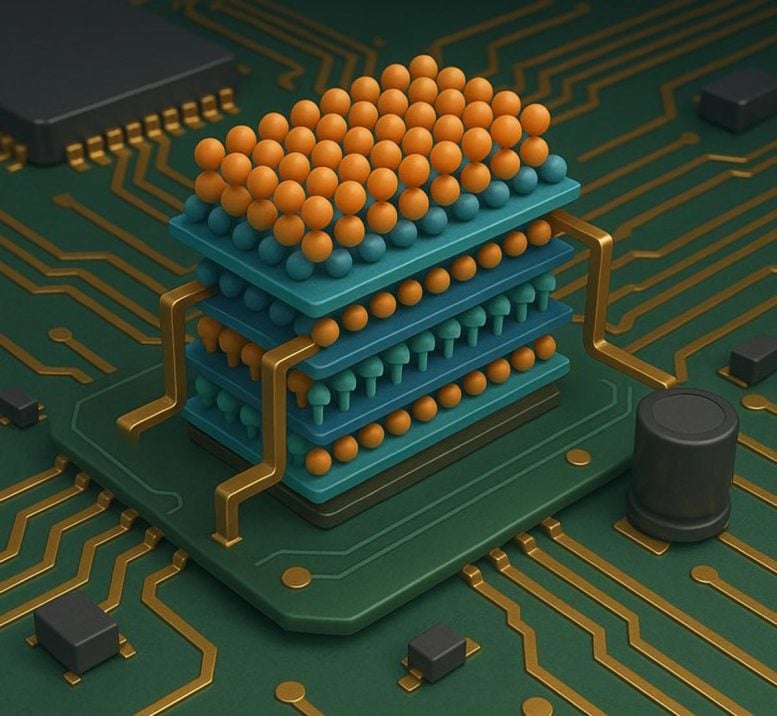
Scientists found a way to control magnetism in ultra-thin materials using CrPS₄, opening the door to more compact and energy-efficient technologies.
A recent scientific breakthrough has unveiled a promising new technique for manipulating magnetism in ultra-thin materials, potentially paving the way for faster, more compact, and energy-efficient technologies.
The method centers around a material called CrPS₄, which is only a few atoms thick. Researchers discovered that they can finely adjust its magnetic properties with high precision, offering a new level of control.
This finding may help resolve a long-standing challenge in material science and could open the door to innovative magnetic technologies, including advanced memory storage and future electronic devices.
Magnetism plays a key role in how digital memory operates. Within computers, tiny magnetic regions are responsible for storing data.
The behavior of these magnetic zones is influenced by a phenomenon known as exchange bias. Historically, exchange bias has been extremely difficult to examine and regulate, largely because it occurs at hidden and flawed interfaces between layered materials.
A Simpler, More Elegant Solution
Researchers from the University of Edinburgh, Boston College, and Binghamton University have devised a way of overcoming these challenges.
Instead of stacking different materials on top of each other, the team discovered they could achieve the same control within CrPS₄, a type of semiconductor.

In ultra-thin flakes of CrPS₄, layers of atoms naturally form regions with different magnetic properties due to its thickness. Using cutting-edge imaging techniques and large-scale simulations, researchers were able to see how magnetic regions formed, interacted, and shifted at the boundaries between different number of layers.
The imaging technique – known as called nitrogen-vacancy (NV) center magnetometry – works like an ultra-sensitive magnetic microscope, using diamond sensors to visualize tiny magnetic fields.
By changing the arrangement of layers within CrPS₄, the researchers found they could turn the exchange bias on or off, like flipping a switch. The process is controllable and reversible, something that could be very useful for future technologies, the team says.
Dr Elton Santos from the University of Edinburgh’s School of Physics and Astronomy, said: “The regions inside CrPS₄ line up side by side like lanes on a highway. The border between them forms a perfect interface, allowing us to study and control magnetic behavior with incredible precision.”
Implications for Future Technology
Not only does the discovery deepen scientists’ understanding of magnetism, it also lays the groundwork for building smarter, smaller, and more reliable magnetic devices, the team says.
It could help engineers design ultra-compact memory chips, reconfigurable sensors, or even quantum computing devices based on magnetic principles. CrPS₄ is stable in air and easy to work with, making it an ideal candidate for real-world applications, not just lab experiments, they add.
Dr Santos continues: “This breakthrough opens a window into the invisible world of atomic-scale magnetism. This work gives us a transparent and reliable platform to understand and engineer magnetism at the atomic scale. It opens the door to a whole new class of magnetic technologies.”
Reference: “Configurable antiferromagnetic domains and lateral exchange bias in atomically thin CrPS4” by Yu-Xuan Wang, Thomas K. M. Graham, Ricardo Rama-Eiroa, Md Ariful Islam, Mohammad H. Badarneh, Rafael Nunes Gontijo, Ganesh Prasad Tiwari, Tibendra Adhikari, Xin-Yue Zhang, Kenji Watanabe, Takashi Taniguchi, Claire Besson, Elton J. G. Santos, Zhong Lin and Brian B. Zhou, 12 June 2025, Nature Materials.
DOI: 10.1038/s41563-025-02259-x
The research received support from UK Research and Innovation (UKRI), the National Science Foundation (NSF) and the Royal Society.
Never miss a breakthrough: Join the SciTechDaily newsletter.
1 Comment
The advancement of nanotechnology seems to be exponential. I’m hard-pressed to keep up with the ingenuity and progressiveness. Composite semipermeable membrane potential might prove to be a futuristic trend.